Frequently Asked Questions
Image Backup
If your question is not addressed below, contact us through our support form and we will get back to you shortly.
Backup
- What is IDrive® 360 image backup and how does it work?
- How do I enable image backup?
- How do I add or configure a computer for image backup?
- How do I perform an image backup of my computer?
- How do I backup an individual disk partition of my computer?
- How do you schedule an image backup for your computer?
- Will the subsequent changes in my already backed up files be transferred incrementally?
- Can I perform image backup for more than one computer?
- How does image backup optimize data transfers?
- Is the backed up data reliable for restore?
- How long can I retain the backed up image data to my account?
- How do I view backup and restore activities logs for a computer?
- How do I view web activity logs specific to Image Backup?
Restore
- Can I perform a snapshot-based restore of my backed up data?
- Can I perform full system-image recovery?
- How to create a WinRE restore media for system-image restore?
- How do I build a bootable WinRE media that includes wireless WiFi support?
- My Windows computer has crashed. Can I restore it using image backup?
- Is it possible to restore specific disk volumes?
- Is it possible to restore individual files and folders?
- Can I restore one computer's data to another computer?
- Can I search a particular file from my account?
- Can I use the ISO build created using IDrive® 360 for multiple computers, at any location?
What is IDrive® 360 image backup and how does it work?
IDrive® 360 disk imaging or image backup allows you to backup single/multiple partitions, or run a full image backup of the hard drive including the operating system (OS), system settings, installed applications, application configurations, and associated VMs, directly to the IDrive Cloud while maintaining recovery points for point-in-time restore.
To enable image-based backup,
- Sign in to your IDrive® 360 account.
- Click 'Image Backup'.
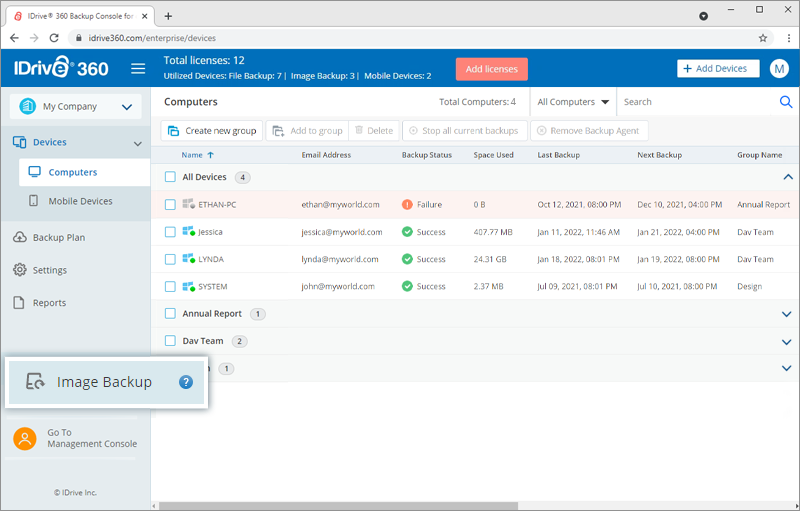
- Click 'Enable Image Backup'.
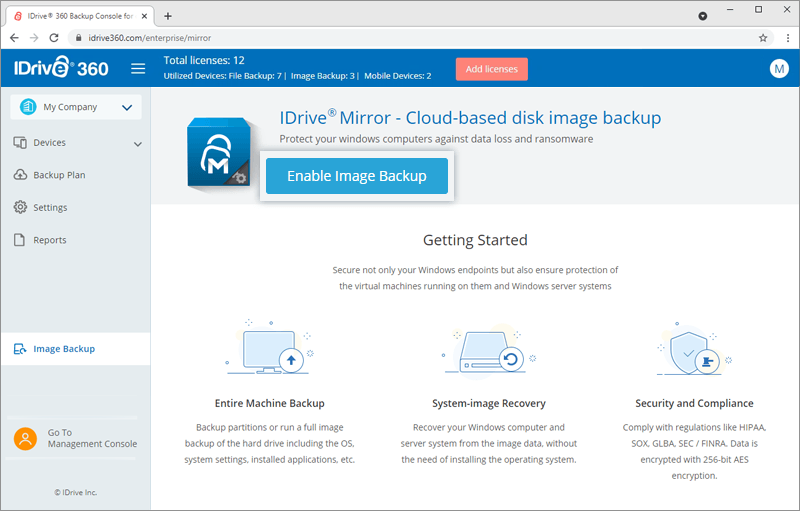
The image backup console will open and the image backup application will be automatically downloaded on your computer. Install the application to configure the computer for image backup.
Initiate a full image backup of the configured computer. By default, your Entire PC will be selected as the backup source.
Your computer will be backed up as the pre-configured backup plan and schedule.
You can also create a backup schedule, change the backup source, modify the email notifications, cleanup, and performance settings for the computer.
How do I add or configure a computer for image backup?
To configure a computer for backup,
- Launch image backup.
- Download and install the desktop application on the Windows computer that you wish to backup.
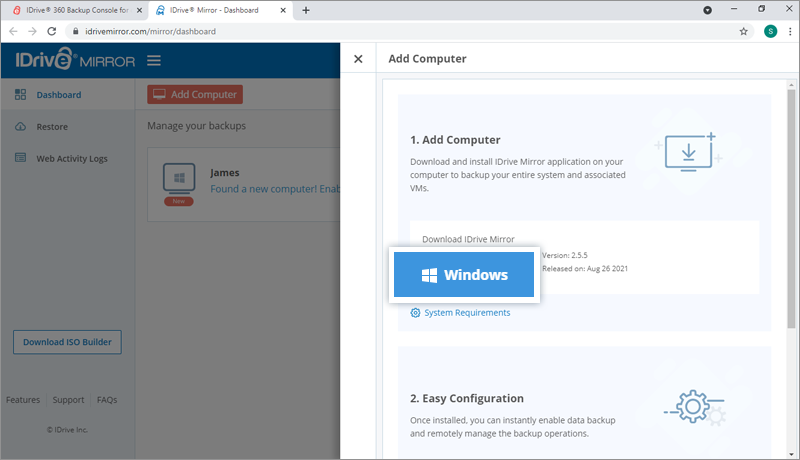
- When the desktop application is installed on your computer, you can enable backup for the configured computer via the desktop application or the web.
To start backup for the configured computer,
- Go to the 'Dashboard' tab.
- Click 'Enable Now' corresponding to the configured computer.
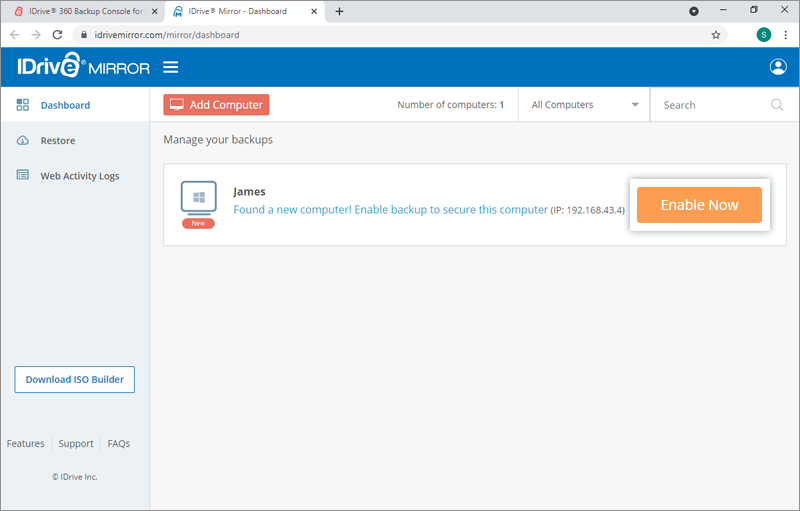
- In the slider window, click 'Enable Now' to initiate a full image backup of the configured computer. By default, your 'Entire PC' will be selected as the backup source.
You can also create a backup schedule, change the backup source, modify the email notifications, cleanup, and performance settings for the computer.
How do I perform an image backup of my computer?
To backup your computer,
- Launch image backup.
- In the 'Dashboard' tab, click 'Backup Now' next to the configured computer.
A slider window will appear on the screen. - To start an immediate full disk-image backup of your computer, click 'Start Full Image Backup' in the slider window.
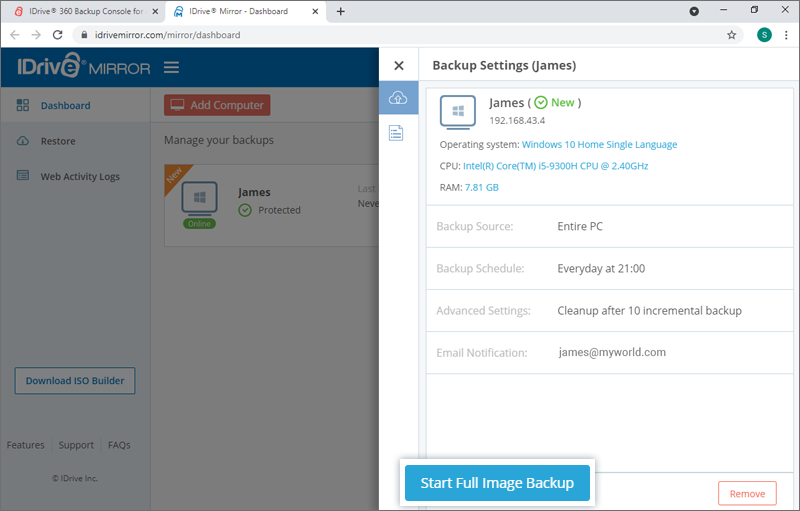
You can also schedule backup for your computer from the 'Backup Schedule' section in the slider window. Schedule backups daily or customize backups by selecting the required days and hours. You can even set an interval between consecutive backups.
How do I backup an individual disk partition of my computer?
By default, image backup selects your entire PC for backup to the cloud. However, you have the option to customize the backup source and upload data from specific drives of your computer.
To backup a disk partition,
- Launch image backup.
- Click
 next to the computer you want to backup.
next to the computer you want to backup. - Click the 'Backup Schedule' tab in the slider window.
- Click 'Customize'.
By default, all the drives are selected for backup.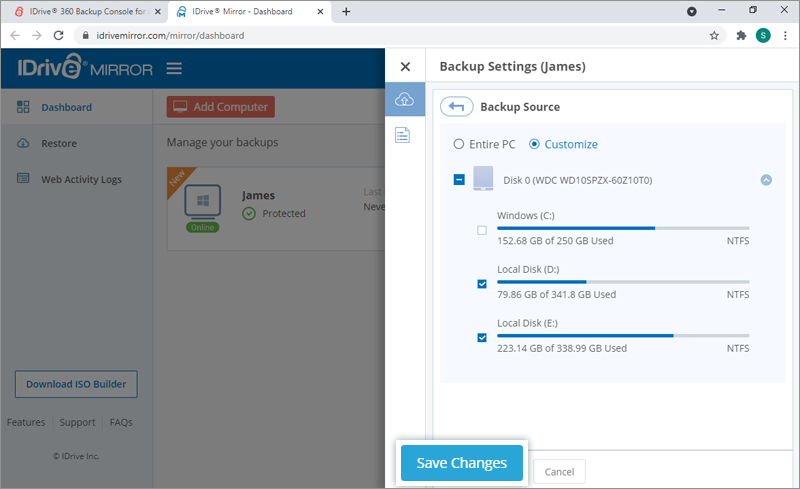
- Deselect the drives that you do not want to backup.
- Click 'Save Changes'.
Note: If you deselect the drive where the operating system is installed, you will not be able to restore the entire computer.
How do you schedule an image backup for your computer?
To schedule image backups,
- Launch image backup.
- Click
 next to the computer you want to create a schedule.
next to the computer you want to create a schedule. - Click the 'Backup Schedule' tab in the slider window.
The 'Schedule Backup' window will appear. - To apply backup settings modify the following options as required:

- Backup Interval: Set the desired interval between consecutive backups from here.
- Daily: Select this radio button if you want to schedule daily backups and set the backup start time.
- Custom: Select this radio button to customize your backup on the required days and hours of the week.
- No Schedule: Click this radio button to disable all scheduled backup settings.
- Start time: Set the time for your scheduled backup to start.
- Click 'Save Changes'.
In the 'Advanced' section, set options to wake up your computer from hibernate/sleep mode for backup and run missed backup on system startup if the computer was turned off during backup.
Backups will occur according to the saved schedule.
Will the subsequent changes in my already backed up files be transferred incrementally?
Yes, after the full initial image backup subsequent changes are backed up incrementally and synced with the existing data through automated data synchronization.
Can I perform image backup for more than one computer?
Yes, you can perform backup for multiple Windows computers directly to the cloud. You can see the list of configured computers in the 'Dashboard' tab. You can select individual or multiple computers at a time from the list for backup.
How does image backup optimize data transfers?
During image backup only the modified portions of your files are transferred after full initial transfer by utilizing the Changed Block Tracking (CBT) technology which conducts up to three times faster backup to optimize your bandwidth usage.
Is the backed up data reliable for restore?
To ensure reliability of the backed up image data, IDrive® 360 runs an immediate data integrity check after each volume is backed up. The data integrity check ensures that only the reliable copies of data are stored during backup and can be restored.
How long can I retain the backed up image data to my account?
The data in your account is cleaned up periodically based on the Cleanup settings defined by you in the web console.
To define Cleanup settings,
- Launch image backup.
- Click
 next to the computer you wish to update Cleanup settings.
next to the computer you wish to update Cleanup settings. - In the 'Backup Settings' window, click 'Advanced Settings'.
- Set the following options in the 'Cleanup' section:

- Automatically perform cleanup after every '-' incremental backup
- Delete versions that are older than '-' months
- Click 'Save Changes'.
How do I view backup and restore activities logs for a computer?
To view image backup and restore logs for a particular computer,
- Launch image backup.
- In the 'Dashboard'
 tab, click corresponding to a computer.
tab, click corresponding to a computer.
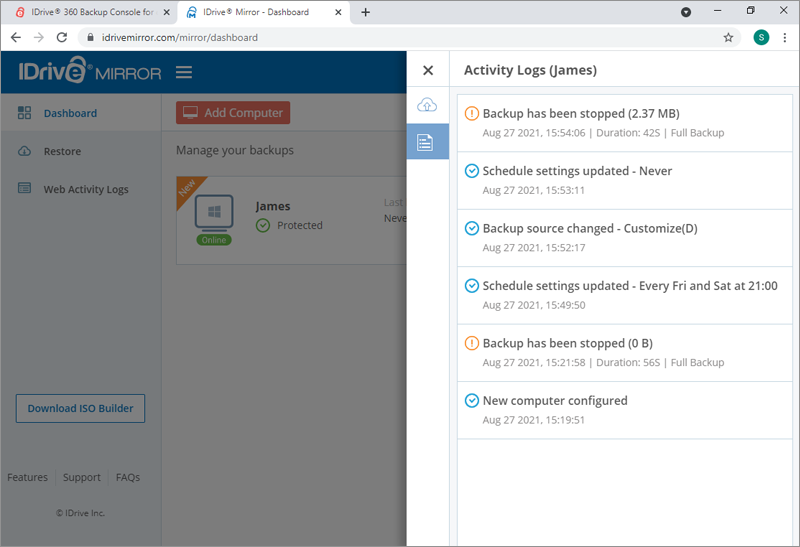
- Click
 .
.
You can also view session logs of your activities during a login session by clicking the 'Notifications' icon on the top right corner of the Dashboard.
How do I view web activity logs specific to Image Backup?
You can view a list of recent web activities for Image Backup from the 'Web Activity Logs' tab. Information such as the date, IP address of the computer, and a description of the activities for the selected period will be displayed on the screen.
To generate logs for any period upto 90 days,
- Launch image backup.
- Go to the 'Web Activity Logs' tab.

- Select 'From Date' and 'End Date' and click 'Generate'.
To download the logs in PDF format, select 'From Date', 'End Date' and click 'Download PDF'.
Can I perform a snapshot-based restore of my backed up data?
Yes, you can perform a snapshot-based image restore for point-in-time recovery of your data backed up to the cloud. The historical backups function as recovery points and let you perform point-in-time data recovery.
Can I perform full system-image recovery?
Yes, you can perform a complete recovery of your Windows computer and server system from the image data, without the need of installing the operating system and other software.
How to create a WinRE restore media for system-image restore?
In order to initiate a WinRE-based system restore, you need to create a bootable USB or media device using the Restore Media Builder app. You can use this bootable WinRE-based recovery media to boot up a Windows computer on which restore needs to be initiated.
To get started,
- Launch image backup.
- Click 'Download ISO Builder'.
Once downloaded, install the Restore Media Builder app on your computer.
To build a WinRE recovery media for future use,
- Launch the Restore Media Builder setup and login.
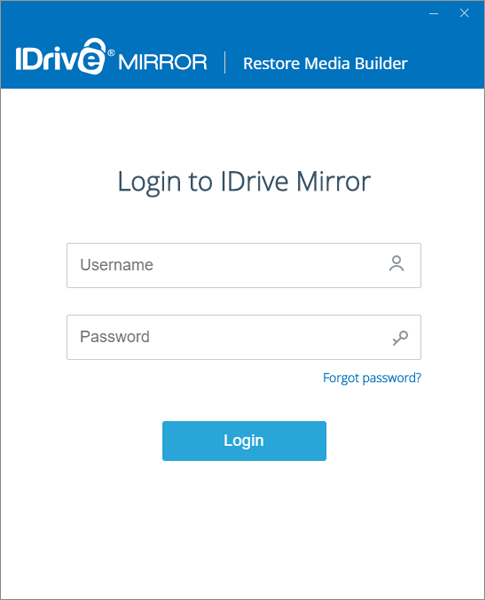
- Select 'Create an ISO'.
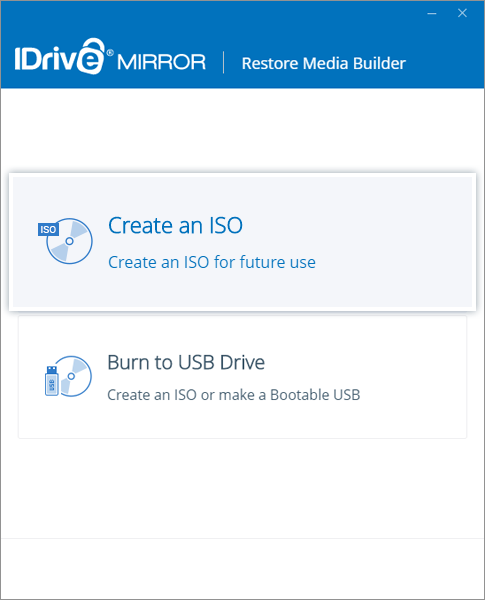
- Select the location where the ISO file needs to be saved from the 'Browse' button and click 'Create ISO file'.
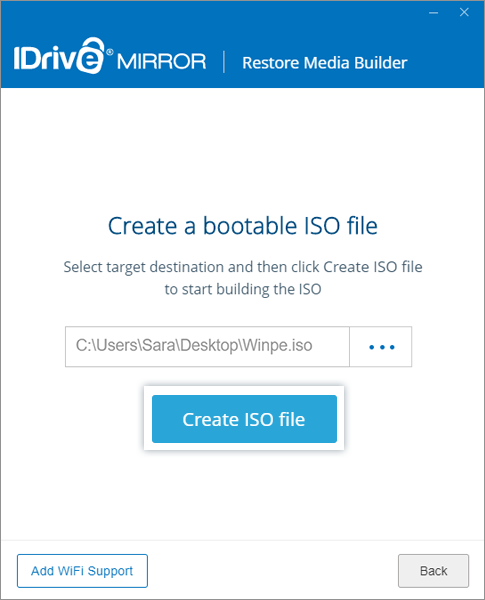
The ISO build progress will be displayed on the page.
You will receive a success message once the rescue media is created.
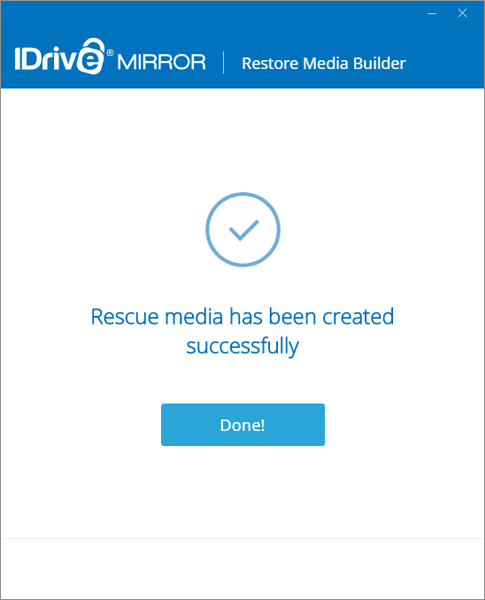
To build a WinRE recovery media for immediate use,
- Connect the USB flash drive to the computer.
- Launch the Restore Media Builder setup and login.

- Select 'Burn to USB drive'.
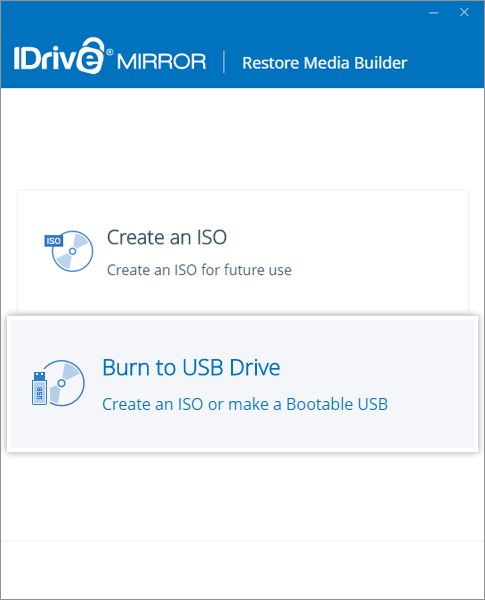
- Select the required USB device as the target drive and choose the partition style from the respective drop-downs.
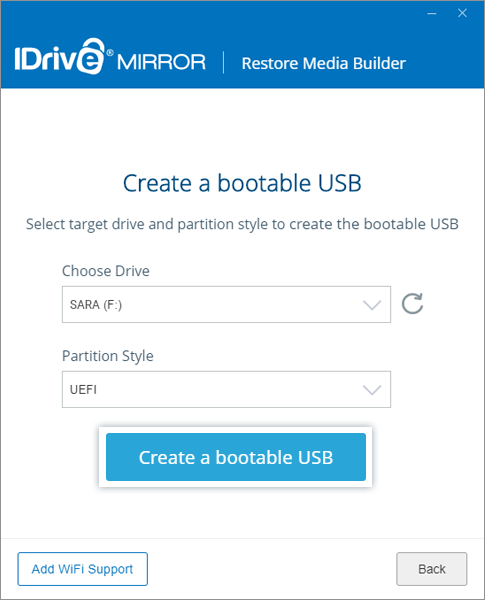
- Click 'Create a bootable USB' to create the boot device.
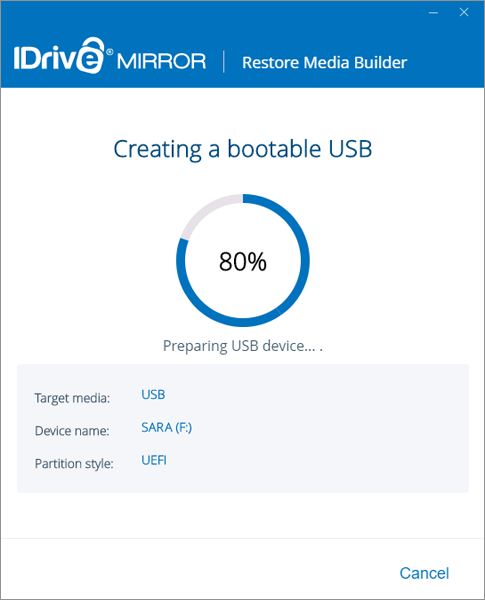
The bootable USB creation progress will be displayed on screen.
You will be notified once the bootable USB device is successfully created along with further instruction to use the bootable device.
Note: If the setup is not able to find the .wim file, you will be prompted to download Windows ADK to complete building the ISO.
How do I build a bootable WinRE media that includes wireless WiFi support?
The Restore Media Builder app enables you to create a WinRE media with support for wireless networks. This means you can easily connect to a wireless network via WinRE.
To add WiFi support to a bootable WinRE media,
- Launch the Restore Media Builder setup and login.
- Select 'Create an ISO' or 'Burn to USB drive' as required.
- Click 'Add WiFi Support'.
- Add a relevant WiFi driver to support the target machine in the 'Add Driver(s) screen. To find the path of the WiFi driver used by your computer, see steps here.
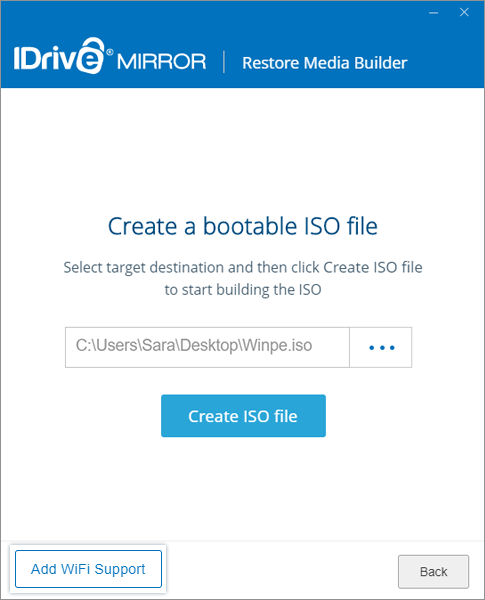
- Click 'Done'.
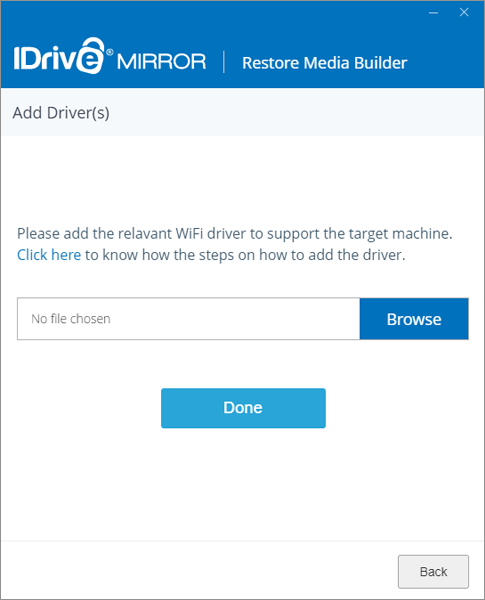
Once the driver is added, a list of all the available WiFi networks around will appear in the WinRE Restore application.
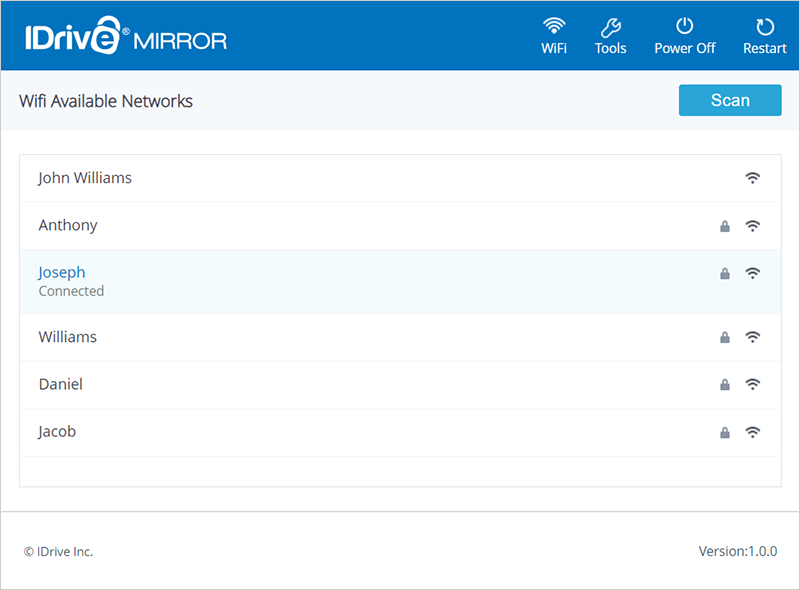
Next, follow the steps given in the above FAQ for building a WinRE-based recovery media for future and immediate use.
My Windows computer has crashed. Can I restore it using image backup?
Yes, you can restore your configured Windows computer from the image backups stored in your account without downtime during data loss or data corruption.
The following prerequisites must be fulfilled to restore data using a WinRE recovery media:
- The boot image architecture that is compatible with the destination computer architecture.
- A target hard drive with sufficient storage space for performing the restore operation.
- Minimum 1 GB RAM in the restore computer is needed to boot the ISO.
- A bootable WinRE ISO file or a USB bootable flash drive.
To restore data using WinRE bootable USB drive,
- Connect the WinRE USB bootable flash drive to the computer.
- Launch the WinRE Restore setup.
- Choose the computer, volume, and backup version that you want to restore.
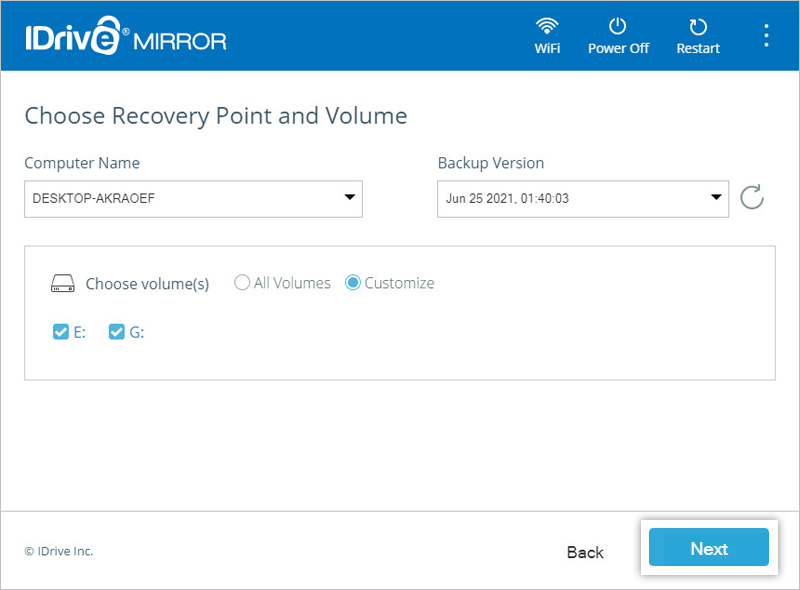
- Click 'Next'.
- Select the target drive you want to restore the selected data and click 'Restore'.
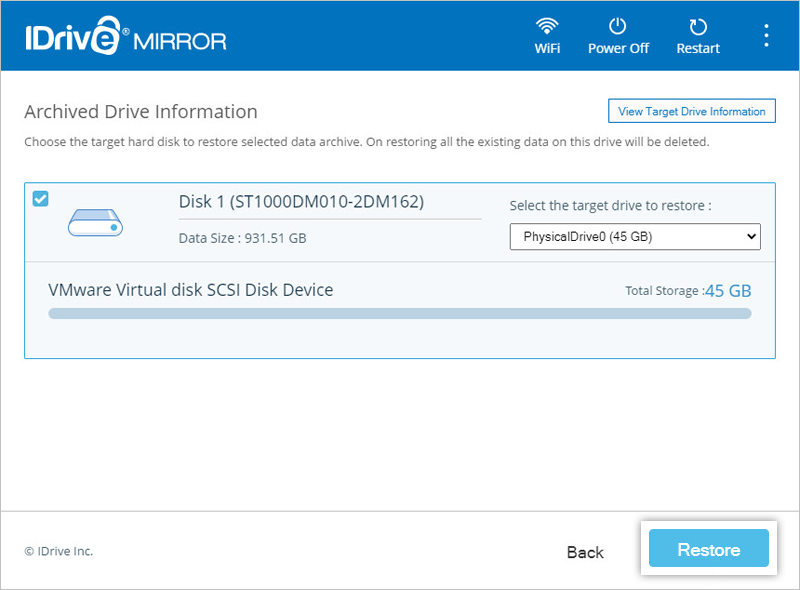
Note: This operation will overwrite the existing data on the target drive.
The restore progress will be displayed and you will receive a message once the restore is complete.
To restore data using WinRE bootable ISO file, attach the ISO file to a virtual machine, and launch the WinRE Restore setup. Then follow the remaining steps for USB data restore.
Is it possible to restore specific disk volumes?
Yes, you can easily restore specific disk volumes.
To perform a volume-level restore,
- Launch image backup.
- Click 'Restore' against the required computer from the dashboard.
- Click 'Image Restore'.
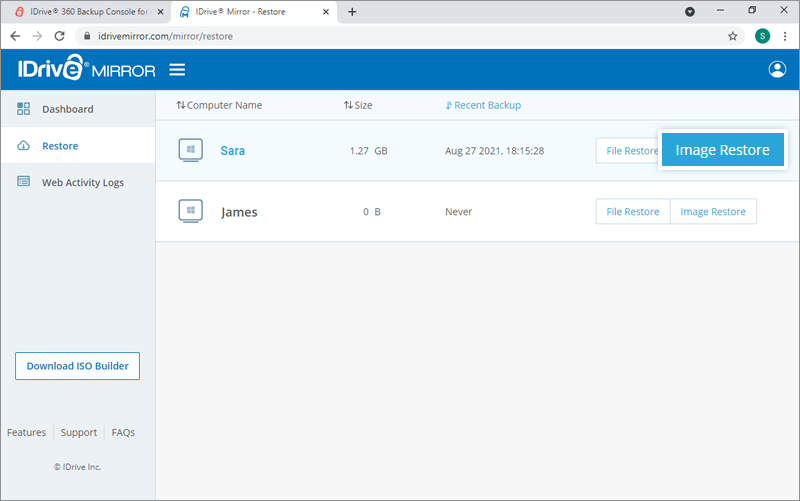
- Choose the required recovery point from the 'Backup Version' section.
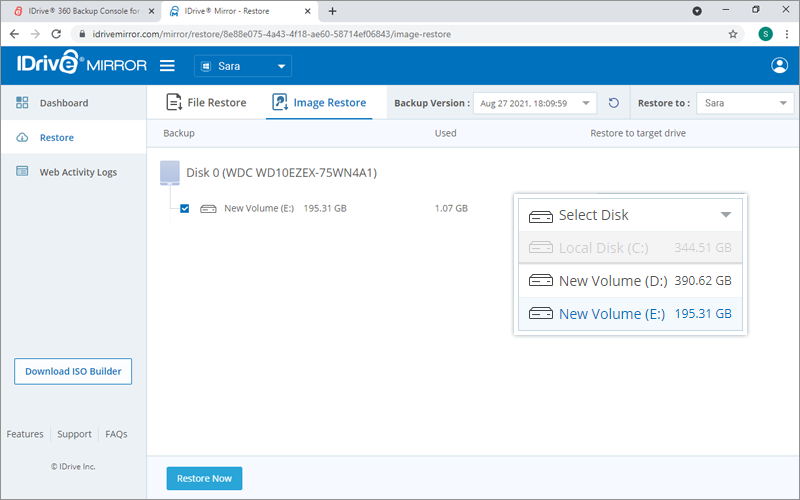
- Select the required disk volume from the list appearing on the screen.
- Click 'Restore Now'.
Note: Volume restore cannot be performed on the location where the operating system is installed on the computer.
Is it possible to restore individual files and folders?
Yes, you can easily restore an individual file or folder.
To perform a file/folder-level restore,
- Launch image backup.
- Click 'Restore' against the required computer from the dashboard.
- Choose the required recovery point from the 'Backup Version' section under 'File Restore'.
- Select the volume containing the file or folder that you want to restore.
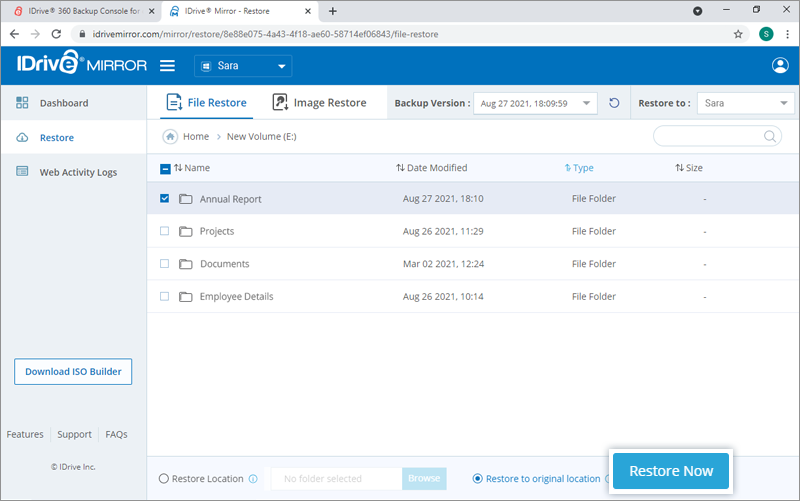
- Select the file or folder that you want to restore.
- Click 'Restore Location'. Choose any location on your computer by clicking 'Browse' to restore the selected files.
- Click 'Restore to original location' if you want to restore the file or folder to its original location on your system.
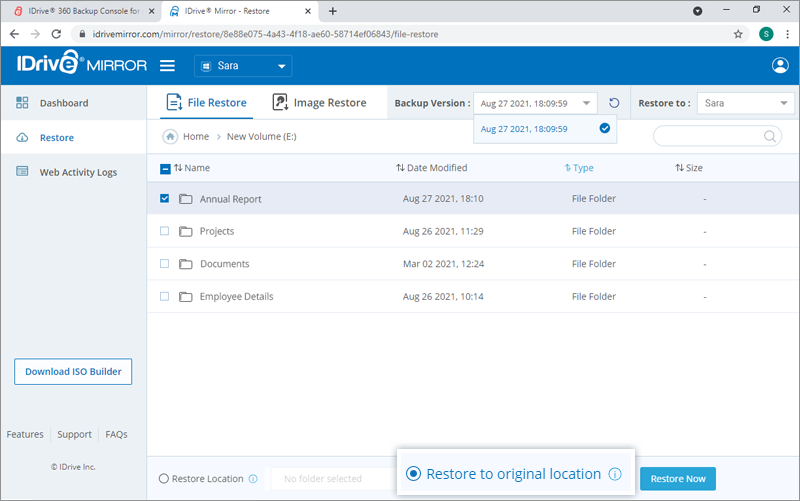
Note:
- To restore files to the original location the structure of the files/folders should be the same as your cloud backup.
- While restoring to the original location your existing files will be overwritten with their corresponding latest version available in the cloud.
- If IDrive® 360 fails to overwrite a file due to some issue, it may save a copy of the file in the same location after affixing the file name with 'restore' and an 'index number' which will keep on increasing in similar instances.
- IDrive® 360 doesn't support 'Original Location Restore' for Operating System and application-related folders like 'Windows', 'Program Files' etc.
- Click 'Restore Now'.
Can I restore one computer's data to another computer?
No, you can perform restore at original location and custom location only on the same computer from where the data was backed up. However, you can download required files to another computer.
To download a file,
- Launch image backup.
- Click 'Restore' against the required computer from the dashboard.
- Choose the required recovery point from the 'Backup Version' section.
- Select the volume containing the file or folder that you want to restore.
- Hover on the file or folder that you want to download and click
 .
.
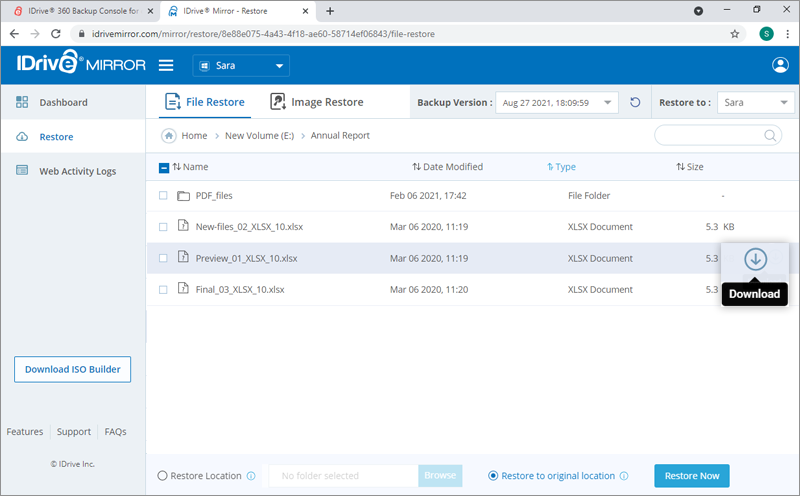
Note: You can only download one file on your system at a time.
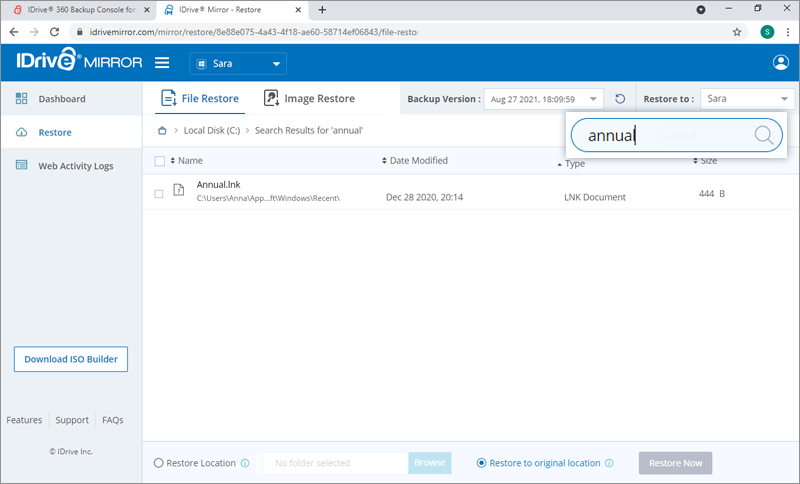
 .
.